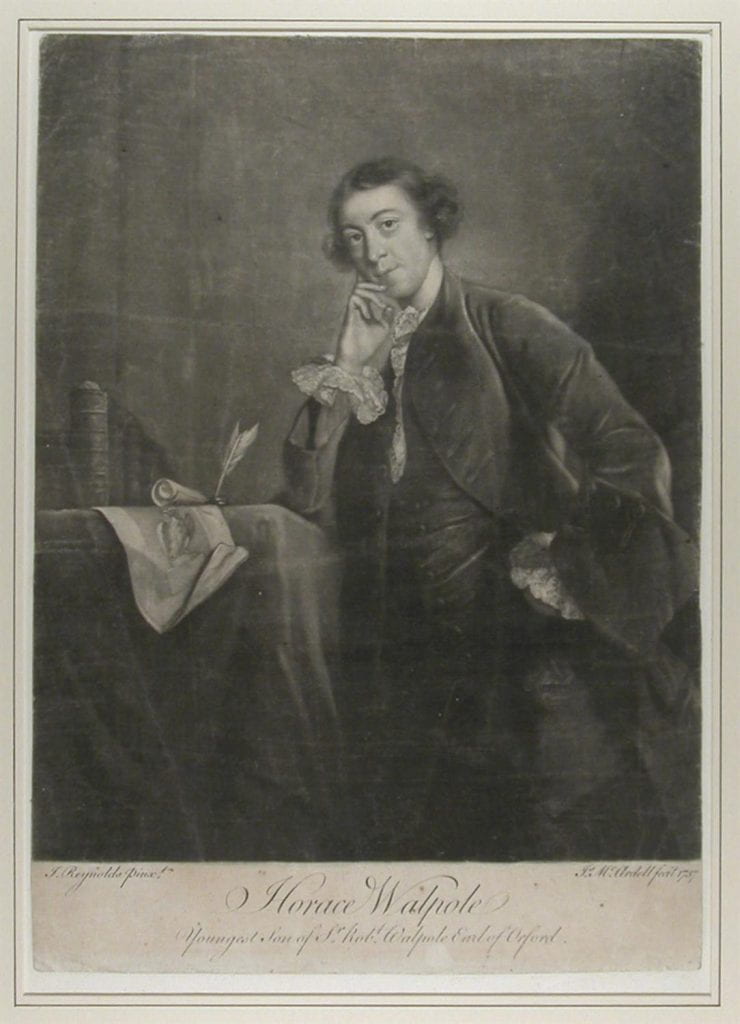37. Choice 26: Walpole’s Annotated Print of His Portrait by Reynolds, 1757
We come now to the final Choice, the copy of McArdell’s print of Walpole engraved after Reynolds in 1757, which Walpole hung in his bedroom at Strawberry Hill. The Strawberry Hill sale catalogue records that “A Latin inscription, in the handwriting of Horace Walpole, is at the back of the engraving, rendering it particularly interesting.” It was bought in 1842 by the Rev. Hon. Horace Cholmondeley, Walpole’s cousin, and thanks to the friendly offices of Owen Morshead came to me in 1962 from General Sir Henry Jackson of Dorset, Horace Cholmondeley’s grandson. The Latin inscription on the ack in Walpole’s most elegant hands is from Historia sui temporis by Jacques Auguste de Thou (1553-1617), historian and statesman. The Warden of All Souls, Mr John Sparrow, kindly translated it for me:
In far distant times, one will look with wonder on the green turf that covers the grave where my ashes are buried, and will say: “It was his lot to be born in a bed of down, blessed with ample means, with favor and resources surpassing those which nowadays all wonder at from their earliest years: the glories of his time, his natural ambition, and the fresh fame of his illustrious father, all gave grounds to hope that he would excel the example of his ancestors which he strove to imitate; yet, despite all this, he preferred to seek the obscure, easeful retreats of the Muses, to shun the rocks and storms of Court and to despise the insubstantial vanities that men contended for: he chose the ivy and the laurel that grow wild rather than the spoils of battle of triumphs that batten on a hungry peace.”
One feels Walpole’s pleasure as he copied out that passage with its remarkable parallels to himself. Like de Thou he would be talked about “in far distant times,” not for the insubstantial vanities that men strive for, but for the enduring awards of the Muses; he would be remembered for his letters and memories as well as for his contributions to the arts, literature, and antiquarianism. The future owners of the objects mentioned in the Description of Strawberry Hill would enjoy them the more because he had owned them.
John Pinkerton in his Walpoliana, in 1799, says that McArdell’s print of Walpole “must have been very like, as strong traces of resemblance remained, particularly about the eyes.” Earlier Pinkerton wrote, “The person of Horace Walpole was short and slender, but compact and neatly formed. When viewed from behind, he had somewhat of a boyish appearance, owing to the form of his person, and the simplicity of his dress. His goodness of his eyes, which would often sparkle with sudden rays of wit, or dart forth flashes of the most keen and intuitive intelligence.” One is reminded of General Fitzwilliam’s witness to Walpole’s “natural talents, his cheerfulness, the sallies of his imagination, the liveliness of his manner.”
The accessories that Reynolds chose to suggest Walpole’s interests give us the virtuoso and writer as well as the man of the world. The tall table on which he is leaning and displaying the ruffles at his wrist has a print of his antique marble eagle that was dug up in Rome in 1742. The Description of Strawberry Hill calls it “one of the finest pieces of Greek sculpture in the world,” and assures us that “the boldness and yet great finishing of the statue are comparable. The eyes inimitable. Mr. Gray has drawn the flagging wing. It stands on a handsome antique sepulchral altar, adorned with eagles too.” Reynold’s portrait also gives us the writer with a quill and inkpot and two or three of his books tumbled together on the tall table.
Lewis, Wilmarth S. Rescuing Horace Walpole. New Haven and London: Yale University Press, 1978.
To see the full chapter from Rescuing Horace Walpole called “Choices 24 and 25: Ramsay’s Portrait of Walpole and Berwick’s of Conway” download or expand the link here:
 Loading...
Loading...
N.B. The collection of eighteenth- and early nineteenth-century British satires in the LWL’s collection have been cataloged in Orbis, Yale’s online library catalog, and through the Quicksearch Books+ interface, and digital images can be found in the Digital Collection.


